
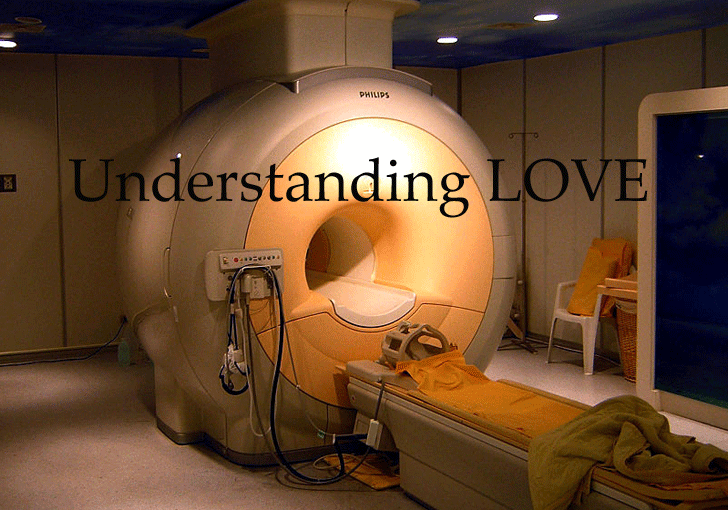
Lust, Romance and Attachment: Shifting Goals
The last three kinds of love, Lust (sexual) love, Romantic (obsessive) love and Attachment (friendship) love are often not distinguished when we speak of "loving" someone. Although each kind of love is driven primarily by a different reward hormone, the systems seem to be hard wired to cooperate with each other automatically.
Sexual love motivates our interest in a subset of potential mates, depending on age and availability. The hypothalamus plays a role in gender preference. Romantic love selects a lover and obsesses over them. Finally, Attachment love incorporates the beloved into our world view and self identity.
Lust (Sexual) Love & Desire
Sexual love begins with hormones like testosterone in both men and women [12]. Athletes taking testosterone for strength and fitness report more sexual thoughts and more morning erections. Middle aged women who use topical testosterone cream report increased sex drive. The effects of these natural sex hormones are hard wired and serve the greater needs of procreation and species survival.
Oxytocin also plays a role in sexual arousal. Oxytocin injected into the cerebrospinal fluid causes spontaneous erections in rats, reflecting actions in the hypothalamus and spinal cord. [15] During arousal, oxytocin inhibits areas of the brain that produce negative thoughts and foster distrust and fear.
Through the libido, sexual hormones energize our body with triggered releases of adrenaline and norepinephrine, increasing our heart rate and creating a state of arousal which triggers the dopamine. This pleasurable neurotransmitter provides the drive to find the objective of desire and achieve the most intense neuro-chemical reward of sexual contact and orgasm.

[Above:] Combined MRI and Positron Emission Tomography (PET) scans for healthy heterosexual males during penile erection and sexual arousal. Activation is in many areas (anterior cingulate, insula, amygdala, hypothalamus, and secondary somatosensory cortices) rich in dopamine innervation and are located mainly on the right side of the brain.[11]
The finding that the cortical activations are found almost exclusively on the right side of the brain corresponds with the results of researchers who reported that the frequency of sexual dysfunction is significantly higher after CVAs (strokes) in the right rather than left hemisphere. [12]
The posterior of the brain shows activity in the visual centers, likely because the erotic stimulus for the experiment involved visual images.
The reward of orgasm triggers all four neuro-chemicals of love along networks that extend throughout the brain. Below is a short video showing the activated networks during a female orgasm.
|
Female orgasm captured in series of brain scans Monday, November 14, 2011 - 16:32 in Psychology & Sociology
Scientists have used brain scan images to create the world's first movie of the female brain as it approaches, experiences and recovers from an orgasm. The animation reveals the steady buildup of activity in the brain as disparate regions flicker into life and then come together in a crescendo of activity before gently settling back down again. To make the animation, researchers monitored a woman's brain as she lay in a functional magnetic resonance imaging (fMRI) scanner and stimulated herself. The research will help scientists to understand how the brain conducts the symphony of activity that leads to sexual climax in a woman. [source] |
During orgasm, blood flow decreases to all regions of the cortex except the prefrontal cortex, where it increases.[13] This is an area rich in dopamine neurons. The brain is literally showered with dopamine pleasure.
The dopamine reward system is so powerful that it stimulates the desire and planning for repetition and more accessibility to the love object. In some animals, sexual orgasm establishes a pair-bond which serves the protection and survivability of their offspring by rearing them as a couple.
"When the female laboratory-maintained prairie vole (Microtus ochrogaster) is mated with a male, she forms a distinct preference for him, associated with a 50% increase of dopamine in the nucleus accumbens. When a dopamine antagonist is injected into the accumbens, the female no longer prefers this partner; and when a feamle is injected with a dopamine agonist, she begins to prefer the conspecific who is present at the time of infusion, even if she has not mated with this male. [19]
Humans have been provided with a similar system to promote pair bonding, based on oxytocin which initiates the next phase: falling in love.
Falling In (Romantic) Love
At least two uncontrolled studies have found increases in plasma oxytocin at orgasm -- in both men and women.[14][17] This reveals natures attempt to encourage bonding following sexual intercourse. High levels of oxytocin remain for only 30 minutes, then fall to normal. This suggests that the time immediately following orgasm, when oxytocin levels are at their peak, is the optimal time for bonding, intimacy and cuddling.
The prevailing view of neuroscientists, notably Helen Fisher, is that process of "falling in love" is a neuro-chemical event that reportedly takes about a fifth of a second to occur [15]. The neural pathways controlling this phenomenon are hard wired and driven by the reward system.
Every species has examples of romantic love. Animals have a preference and decide with whom they will mate and bond. We don't know why a particular partner is chosen from many similar possibilities but some believe that we select mates based on our similarities in the levels of various neuro-chemicals, somehow determined by behavior [15]. Previous studies have implicated pheromones -- unique scents given off in perspiration -- that reveal compatible and complimentary immune systems -- which benefit the offspring [21]. To date, we just do not know why we fall in love with our partners.
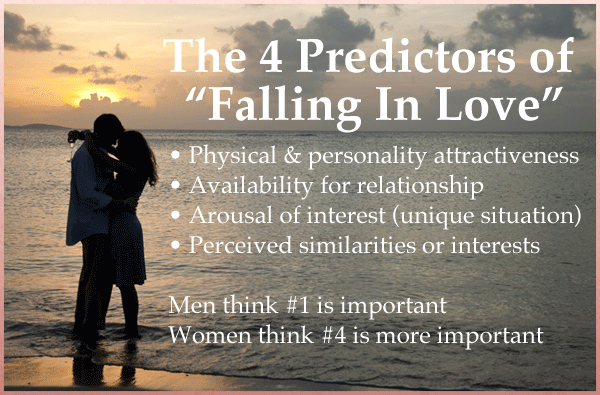
[22]
While confirming the major role of oxytocin, professor Stephanie Ortigue from Syracuse University noted that falling in love is not only instantaneous but it can elicit the same euphoric feelings as cocaine because both share the same reward system.
Oxytocin can inhibit intellectual areas of the brain, especially those that would be critical of the beloved, making us "love blind". Addicts have the same tendency to self-deceive and rationalize their continued drug use, despite knowing it is harmful to them. There is a growing belief that Romantic love is even more addictive than opiates. It has the three qualities of addiction: tolerance, withdrawl and relapse.
Oxytocin release during Romantic love lowers serotonin which can cause confusion and obsessive thoughts about the beloved. These same brain centers are responsible for obsessive-compulsive disorders (OCD).
Although it has been successful with animals, there have been few published experiments where humans were given oxytocin, then watched to see if they bonded with a nearby mate. Such things, although unethical, have almost certainly been attempted. Artificially raising the brain's oxytocin would be the recipe for a real "love potion" with regards to bond forming.
Oxytocin is degraded when ingested. It can be injected into the blood stream but it will not cross the blood brain barrier. Aside from injecting it into spinal fluid, the only way of introducing oxytocin to the brain is through a nasal spray. And now we have just that... con-artists and gigolos take notice.
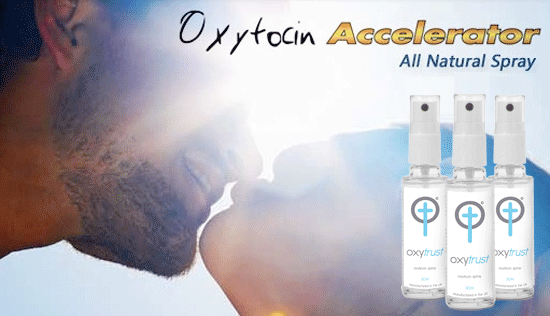
"Researchers now report they can boost oxytocin in the human brain using a nasal spray. And when they do, trust seems to rise and social fear seems to abate, raising the possibility that oxytocin-based drugs might eventually help people with mental illnesses that involve fear of others, from crippling shyness to autism and schizophrenia.This month, Meyer-Lindenberg and others reported in The Journal of Neuroscience that when young men snorted oxytocin, brain scans showed that fear centers became less responsive to threatening faces.
The journal Nature recently published research showing that when subjects played a game that hinged on trust, those who had snorted oxytocin were more likely to trust other players.
[source]
|
Falling in love releases Nerve Growth Hormone (NGH)
Nerve growth factor may contribute to increased longevity and mental capacity. Centenarian Rita Levi-Montalcini [right] took a daily solution in the form of eye drops, and has stated that her brain is more active now than it was four decades ago. NGF prevents or reduces neuronal degeneration in animal models of neurodegenerative diseases and these encouraging results in animals have led to several clinical trials in humans. NGF has also been shown to promote peripheral nerve regeneration in rats. NGF appears to promote myelin repair. Hence NGF may be useful for the treatment of multiple sclerosis.
|
Moving goals in the striatum
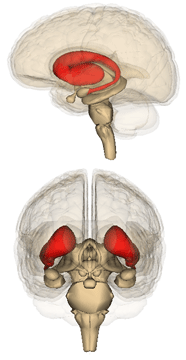 According to a study published in The Journal of Sexual Medicine, Sexual desire and Romantic love activate different areas of the striatum [right].
According to a study published in The Journal of Sexual Medicine, Sexual desire and Romantic love activate different areas of the striatum [right].
The area activated by Sexual Love (desire) is usually activated by things that are inherently pleasurable, such as sex and food. The area activated by Romantic Love is involved in the process of rewarding behavior associated with, but not primarily related to things like sex and food. That is, as feelings of sexual desire develop into love, their processing moves to a different place in the striatum. Call it the "love zone".[15]
As described above, the initial goal of these brain systems is procreation (the sex act), associated with the dopamine-rich orgasm. Driven by mounting testosterone and oxytocin, a realistic means to achieve this goal is undertaken, a probable partner is selected from what is available and we "fall in love".
The oxytocin system continues to stimulate bonding during this Romantic love period and the sex, for a time, maintains pleasurable dopamine levels. Ironically, men's testosterone drops after falling in love, while women's levels go up. For a while, both sex drives are about equal and all is well... But not for long.
Like most addictions, over time the dopamine receptors become numb to the same old stimulus. If the bonding has not been sufficiently established through activities that raise oxytocin levels then the relationship could end.
Bonding provides comfort, safety, security, less anxiety and less fear through the release of oxytocin which inhibits brain centers that usually produce the opposite feelings. Bonding is the behavior that the neural network is hard wired to reward. Bonding also appears to promote health and prolong life.
As dopamine rewards become less intense in a relationship, increased oxytocin throttles down our negative emotions and promotes happiness and trust. Evolutionists say that all of this neuro-chemistry and hard wiring is designed to keep both parents together after mating to better protect and nurture their offspring.
Can there be Romantic Love Without Sex?
Many of us have felt strong feelings of obsessive love without sex -- even without the partner knowing that we existed! But was it really love that we felt? Being infatuated with someone (low serotonin) with whom you have never been intimate is more desire and lust, although it's dressed up a bit. The imagination is capable of consummating sexual love through masturbation or meditation on the love object and the brain (not being able to distinguish the real from imagined) quickly initiates the oxytocin induced bonding, followed by the lower serotonin and resulting obsessive thoughts.
The terry cloth mother in Harlow's monkey experiments reminds us that love can exist in the imagination of the unloved, and still be rewarded.
Overlapping love networks... what can it tell us?
Here are some interesting examples of overlapping kinds of love. With a few exceptions, most of the active regions stimulated by Romantic love are identical to those seen in Maternal love [see below].
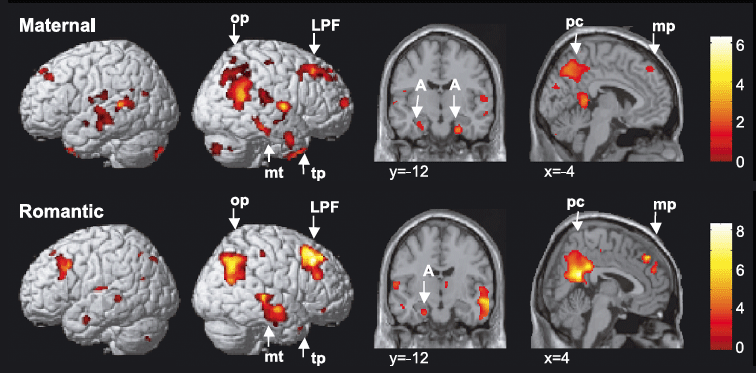
Evolutionary theorists have argued that the system of infant-mother bonding was initially evolved to keep children and parents close for safety and survival. They say that pair bonding between a couple was co-opted for the purpose of keeping reproductive partners together long enough to rear offspring [20]. In other words, adult pair bonding may be an ex-aptation -- a system that originally evolved for one reason, but comes to serve another.
Could this similarity of active regions imply that, like the hypothetical lack of oxytocin neurons in Harlow's experiment, people with deficiencies of Maternal love may also be deficient in their capacity for Romantic love? It seems likely but more work has to be done on this topic.
Next -- Attachment Love: Enduring Companionship

[8] Insel and Young, 2001; Pedersen, 1997; Pedersen et al., 1982; Winslow et al., 1993
[9] Ferguson et al., 2000; Insel and Young, 2001; Winslow et al., 1993
[10] http://www.ajnr.org/content/29/10/1890/F3.expansion.html
[11] http://www.sciencedirect.com/science/article/pii/S1053811905001965
[12] Edwards & Booth, 1994; Serman, 1994; Van Goozen, Wiegant, Endert, Helmond & Van de Poll, 1997
[13] Tiihonen et al., 1994
[14] Carmichael MS, Humbert R, Dixen J, Palmisano G, Greenleaf W, Davidson JM (January 1987). "Plasma oxytocin increases in the human sexual response". The Journal of Clinical Endocrinology and Metabolism 64 (1): 27-31.
[15] Gimpl G, Fahrenholz F (April 2001). "The oxytocin receptor system: structure, function, and regulation". Physiological Reviews 81 (2): 629-83.
[16] Stephanie Caloppo, Francesco Blanchi-Demicheli, Chris Frum, James G. Pfaus, James W. Lewis, "The Common Neural Bases Between Sexual Desire and Love: A Multilevel Kernel Density fMRI Analysis," The Journal of Sexual Medicine, 2012; 9 (4)
[17] http://jcem.endojournals.org/content/65/4/738.short
[18] Carmichael MS, Warburton VL, Dixen J, Davidson JM (February 1994). "Relationships among cardiovascular, muscular, and oxytocin responses during human sexual activity". Archives of Sexual Behavior 23 (1): 59-79.
[19] Gingrich, B., Liu, Y., Cascio, C. Z., & Insel, T. R. (2000) Dopamine D2 receptors in the nucleus accumbens are important for social attachment in female prairie voles (Microtus ochrogaster). Behavioral Neuroscience, 114. 173-184
[20] Lisa M. Diamond, "Emerging Perspectives pn Distinctions Between Romantic Love and Sexual Desire", American Psychological Society (2004), Vol 13, No. 3
[21] University of California - Berkeley (2007, February 8). "Male Sweat Boosts Women's Hormone Levels", ScienceDaily Retrieved March 5, 2013, from http://www.sciencedaily.com/releases/2007/02/070207172019.htm
[22] Galperin_Haselton_2010_Predictors_of_falling_in_love.pdf
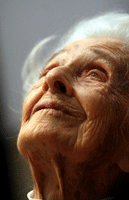 In 2005, Enzo Emanuele and coworkers at University of Pavia found that nerve growth factor (NGF) has high levels when people first fall in love, but these levels return to as they were after one year. To be specific, four neurotrophin levels of 58 subjects who had recently fallen in love were compared with levels in a control group who were either single or already engaged in a long-term relationship. The results showed that NGF levels were significantly higher in the subjects in love than as compared to either of the control groups.
In 2005, Enzo Emanuele and coworkers at University of Pavia found that nerve growth factor (NGF) has high levels when people first fall in love, but these levels return to as they were after one year. To be specific, four neurotrophin levels of 58 subjects who had recently fallen in love were compared with levels in a control group who were either single or already engaged in a long-term relationship. The results showed that NGF levels were significantly higher in the subjects in love than as compared to either of the control groups. 